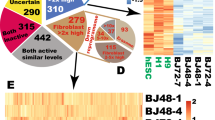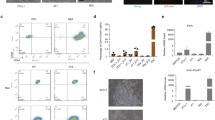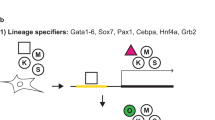Abstract
The overexpression of defined transcription factors in somatic cells results in their reprogramming into induced pluripotent stem (iPS) cells1,2,3. The extremely low efficiency and slow kinetics of in vitro reprogramming suggest that further rare events are required to generate iPS cells. The nature and identity of these events, however, remain elusive. We noticed that the reprogramming potential of primary murine fibroblasts into iPS cells decreases after serial passaging and the concomitant onset of senescence. Consistent with the notion that loss of replicative potential provides a barrier for reprogramming, here we show that cells with low endogenous p19Arf (encoded by the Ink4a/Arf locus, also known as Cdkn2a locus) protein levels and immortal fibroblasts deficient in components of the Arf–Trp53 pathway yield iPS cell colonies with up to threefold faster kinetics and at a significantly higher efficiency than wild-type cells, endowing almost every somatic cell with the potential to form iPS cells. Notably, the acute genetic ablation of Trp53 (also known as p53) in cellular subpopulations that normally fail to reprogram rescues their ability to produce iPS cells. Our results show that the acquisition of immortality is a crucial and rate-limiting step towards the establishment of a pluripotent state in somatic cells and underscore the similarities between induced pluripotency and tumorigenesis.
This is a preview of subscription content, access via your institution
Access options
Subscribe to this journal
Receive 51 print issues and online access
$199.00 per year
only $3.90 per issue
Buy this article
- Purchase on Springer Link
- Instant access to full article PDF
Prices may be subject to local taxes which are calculated during checkout




Similar content being viewed by others
References
Hochedlinger, K. & Plath, K. Epigenetic reprogramming and induced pluripotency. Development 136, 509–523 (2009)
Takahashi, K. et al. Induction of pluripotent stem cells from adult human fibroblasts by defined factors. Cell 131, 861–872 (2007)
Takahashi, K. & Yamanaka, S. Induction of pluripotent stem cells from mouse embryonic and adult fibroblast cultures by defined factors. Cell 126, 663–676 (2006)
Maherali, N. et al. Directly reprogrammed fibroblasts show global epigenetic remodeling and widespread tissue contribution. Cell Stem Cell 1, 55–70 (2007)
Okita, K., Ichisaka, T. & Yamanaka, S. Generation of germline-competent induced pluripotent stem cells. Nature 448, 313–317 (2007)
Wernig, M. et al. In vitro reprogramming of fibroblasts into a pluripotent ES-cell-like state. Nature 448, 318–324 (2007)
Hockemeyer, D. et al. A drug-inducible system for direct reprogramming of human somatic cells to pluripotency. Cell Stem Cell 3, 346–353 (2008)
Maherali, N. et al. A high-efficiency system for the generation and study of human induced pluripotent stem cells. Cell Stem Cell 3, 340–345 (2008)
Wernig, M. et al. A drug-inducible transgenic system for direct reprogramming of multiple somatic cell types. Nature Biotechnol. 26, 916–924 (2008)
Collado, M., Blasco, M. A. & Serrano, M. Cellular senescence in cancer and aging. Cell 130, 223–233 (2007)
Parrinello, S. et al. Oxygen sensitivity severely limits the replicative lifespan of murine fibroblasts. Nature Cell Biol. 5, 741–747 (2003)
Zindy, F. et al. Arf tumor suppressor promoter monitors latent oncogenic signals in vivo . Proc. Natl Acad. Sci. USA 100, 15930–15935 (2003)
Stadtfeld, M., Maherali, N., Breault, D. T. & Hochedlinger, K. Defining molecular cornerstones during fibroblast to iPS cell reprogramming in mouse. Cell Stem Cell 2, 230–240 (2008)
Brambrink, T. et al. Sequential expression of pluripotency markers during direct reprogramming of mouse somatic cells. Cell Stem Cell 2, 151–159 (2008)
Sharpless, N. E. et al. Loss of p16Ink4a with retention of p19Arf predisposes mice to tumorigenesis. Nature 413, 86–91 (2001)
Serrano, M. et al. Role of the INK4a locus in tumor suppression and cell mortality. Cell 85, 27–37 (1996)
Bennett, D. C., Cooper, P. J. & Hart, I. R. A line of non-tumorigenic mouse melanocytes, syngeneic with the B16 melanoma and requiring a tumour promoter for growth. Int. J. Cancer 39, 414–418 (1987)
Kamijo, T. et al. Tumor suppression at the mouse INK4a locus mediated by the alternative reading frame product p19ARF. Cell 91, 649–659 (1997)
Hanna, J. et al. Direct reprogramming of terminally differentiated mature B lymphocytes to pluripotency. Cell 133, 250–264 (2008)
Ventura, A. et al. Cre-lox-regulated conditional RNA interference from transgenes. Proc. Natl Acad. Sci. USA 101, 10380–10385 (2004)
Dickson, M. A. et al. Human keratinocytes that express hTERT and also bypass a p16(INK4a)-enforced mechanism that limits life span become immortal yet retain normal growth and differentiation characteristics. Mol. Cell. Biol. 20, 1436–1447 (2000)
Mali, P. et al. Improved efficiency and pace of generating induced pluripotent stem cells from human adult and fetal fibroblasts. Stem Cells 26, 1998–2005 (2008)
Zhao, Y. et al. Two supporting factors greatly improve the efficiency of human iPSC generation. Cell Stem Cell 3, 475–479 (2008)
Molofsky, A. V. et al. Increasing p16INK4a expression decreases forebrain progenitors and neurogenesis during ageing. Nature 443, 448–452 (2006)
Krishnamurthy, J. et al. p16INK4a induces an age-dependent decline in islet regenerative potential. Nature 443, 453–457 (2006)
Janzen, V. et al. Stem-cell ageing modified by the cyclin-dependent kinase inhibitor p16INK4a. Nature 443, 421–426 (2006)
Eminli, S. et al. Differentiation stage determines reprogramming potential of hematopoietic cells into iPS cells. Nature Genet (in the press)
Sommer, C. A. et al. iPS cell generation using a single lentiviral stem cell cassette. Stem Cells 27, 543–549 (2008)
Ventura, A. et al. Restoration of p53 function leads to tumour regression in vivo . Nature 445, 661–665 (2007)
Acknowledgements
We thank M. Roussel and C. Sherr for providing us with Arf–GFP cells, D. C. Bennett and E. Sviderskaya for sharing Melan A cells, and A. Ventura and T. Jacks for tail biopsies of conditional Trp53-mutant mice. We also thank A. Tzatsos and N. Bardeesy for suggestions, for critical reading of the manuscript and for providing Ink4a/Arf-/- MEFs. We are grateful to P. Follett for blastocyst injections and L. Prickett and K. Folz-Donahue for assistance with FACS. J.U. was supported by a postdoctoral fellowship from the Mildred Scheel Foundation, J.M.P. by an ECOR fellowship, and M.S. by a fellowship from the Schering Foundation. J.G.R. was supported by an NIH Skin Disease Research Center Grant. N.M. was supported by a graduated scholarship from the Natural Sciences and Engineering Council of Canada. Support to K.H. came from the NIH Director’s Innovator Award, the Harvard Stem Cell Institute, the Kimmel Foundation and the V Foundation.
Author Contributions J.U., J.M.P. and K.H. conceived the study, interpreted results and wrote the manuscript, J.U. and J.M.P. performed most of the experiments with help from W.K., R.M.W. and A.K. M.S., N.M. and J.G.R. provided essential study material and helped with interpretation of results.
Author information
Authors and Affiliations
Corresponding author
Supplementary information
Supplementary Information
This file contains Supplementary Figures 1-11 with Legends and Supplementary Tables 1-2. (PDF 7056 kb)
Rights and permissions
About this article
Cite this article
Utikal, J., Polo, J., Stadtfeld, M. et al. Immortalization eliminates a roadblock during cellular reprogramming into iPS cells. Nature 460, 1145–1148 (2009). https://doi.org/10.1038/nature08285
Received:
Accepted:
Published:
Issue Date:
DOI: https://doi.org/10.1038/nature08285
This article is cited by
-
Restricting epigenetic activity promotes the reprogramming of transformed cells to pluripotency in a line-specific manner
Cell Death Discovery (2023)
-
B1 SINE-binding ZFP266 impedes mouse iPSC generation through suppression of chromatin opening mediated by reprogramming factors
Nature Communications (2023)
-
p16High senescence restricts cellular plasticity during somatic cell reprogramming
Nature Cell Biology (2023)
-
Enhanced O-GlcNAc modification induced by the RAS/MAPK/CDK1 pathway is required for SOX2 protein expression and generation of cancer stem cells
Scientific Reports (2022)
-
Retrotransposon instability dominates the acquired mutation landscape of mouse induced pluripotent stem cells
Nature Communications (2022)
Comments
By submitting a comment you agree to abide by our Terms and Community Guidelines. If you find something abusive or that does not comply with our terms or guidelines please flag it as inappropriate.



